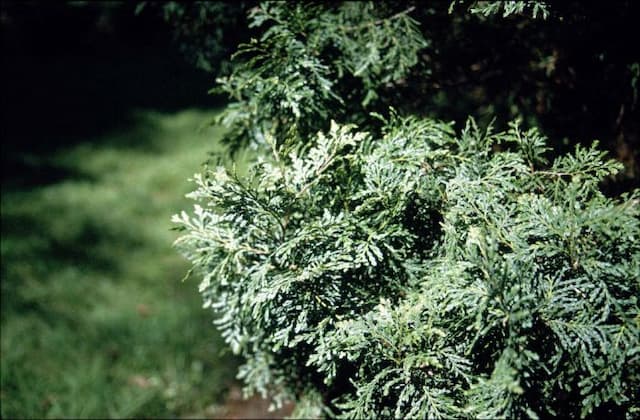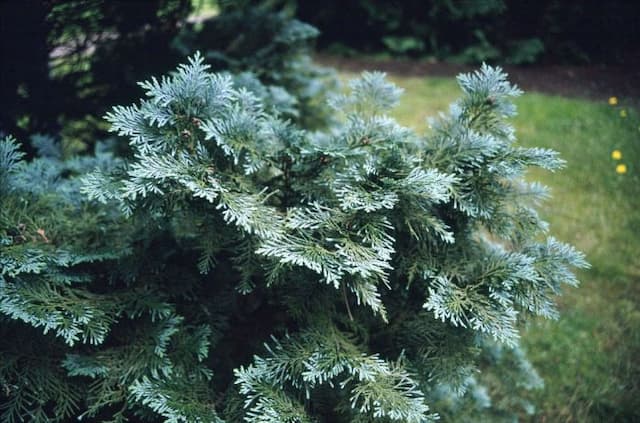Mexican Cypress Cupressus lusitanica











ABOUT
The plant known commonly as the Mexican cypress is a striking evergreen conifer that typically has a dense, conical shape. The leaves of this tree are small, scale-like, and arranged in somewhat flattened sprays that cling tightly to the branches, presenting a rich green to bluish or greyish-green color that remains vibrant throughout the year. The bark of the Mexican cypress is fibrous with a stringy texture, peeling off in narrow strips. It has a reddish-brown to greyish color, which often gives the tree an attractively rugged look. As the tree matures, the bark becomes deeply furrowed, adding to its character. The plant produces both male and female cones on the same tree. The male cones are small, elongated, and release pollen, while the female cones are more substantial, round, and woody. These female cones start out green but gradually mature to a dark brown color and can be seen conspicuously nestled among the foliage. Upon maturity, the cones open to release seeds, but some may remain closed and attached to the branches for many years. Overall, the Mexican cypress is admired for its symmetrical growth habit and lush, evergreen foliage that brings a sense of permanence and tranquility to landscapes. Its striking appearance, with a dense cloak of foliage and a rugged bark texture, makes it an impressive sight to behold.
About this plant
 Names
NamesFamily
Cupressaceae.
Synonyms
Mexican White Cedar, Cedar of Goa, Cedro Blanco, Ciprés, Portuguese Cedar, Cedro Limón, Limón Cedar, White Cedar.
Common names
Cupressus benthamii, Cupressus lindleyi, Cupressus lusitanica var. lindleyi, Cupressus lusitanica var. benthamii, Cupressus knightiana.
 Toxicity
ToxicityTo humans
The Mexican Cypress is generally not considered toxic to humans. There are no well-documented cases of poisoning or toxic reactions following ingestion of any part of the plant in humans. However, it's always advisable to avoid ingesting plants that are not recognized as food due to potential unknown toxicities or individual allergic reactions.
To pets
The Mexican Cypress is also not specifically known to be toxic to pets. However, as with humans, ingestion of non-food plants can lead to gastrointestinal upset or other issues in pets, so it's best to prevent them from chewing on or consuming this plant. If a pet does ingest some of the plant and shows signs of illness, it is advisable to contact a veterinarian.
 Characteristics
CharacteristicsLife cycle
Perennials
Foliage type
Evergreen
Color of leaves
Green
Height
40-60 feet (12-18 meters)
Spread
10-20 feet (3-6 meters)
Plant type
Tree
Hardiness zones
7
Native area
Mexico
Benefits
 General Benefits
General Benefits- Ornamental Value: Mexican cypress is commonly used in landscaping and gardens for its aesthetic appeal due to its pyramidal shape and evergreen foliage.
- Erosion Control: Its root system helps stabilize soil and prevent erosion on slopes or in areas susceptible to soil loss.
- Windbreaks: Due to its density and height, Mexican cypress can act as an effective windbreak, protecting areas from strong winds.
- Privacy Screens: Mexican cypress can be planted in rows to create natural privacy screens around properties.
- Habitat for Wildlife: The tree provides habitat and nesting sites for various bird species, as well as shelter for other wildlife.
- Wood Production: The wood of Mexican cypress is valued for its durability and resistance to decay, making it useful for construction, fencing, and furniture.
- Shade Provider: Large specimens can provide significant shade, creating cooler environments during hot days.
 Medical Properties
Medical Properties- Antimicrobial: The essential oils of Cupressus lusitanica have been studied for their antimicrobial properties against various pathogens.
- Antifungal: Extracts from the tree may exhibit antifungal activity, potentially useful in treating fungal infections.
- Anti-inflammatory: Some compounds in the essential oils may have anti-inflammatory effects, which could help reduce inflammation.
- Antioxidant: The plant may contain antioxidants, which can help protect the body from oxidative stress and free radical damage.
- Expectorant: It's suggested that the essential oils from this plant may have expectorant properties, aiding in the clearance of mucus from the respiratory tract.
- Wound healing: There is some evidence to suggest that Cupressus lusitanica may promote wound healing due to its antimicrobial and anti-inflammatory properties.
 Air-purifying Qualities
Air-purifying QualitiesThis plant is not specifically known for air purifying qualities.
 Other Uses
Other Uses- Cedarwood Oil: Cupressus lusitanica is a source of cedarwood oil, which is used in aromatherapy, perfumes, and as an insect repellent.
- Wood Carving: The wood of Cupressus lusitanica is durable and has a distinctive smell and grain, which makes it desirable for wood carving and crafting decorative objects.
- Fence Posts: Due to its resistance to rot and insects, the wood of this tree is used for making fence posts and other outdoor structures.
- Erosion Control: This plant's extensive root system makes it effective for soil erosion control on slopes and hillsides.
- Windbreaks and Hedges: The dense foliage of Cupressus lusitanica makes it suitable for use as windbreaks or privacy hedges in landscaping.
- Cultural Significance: In some cultures, the plant is used in rituals or as a symbol of mourning and remembrance in cemeteries.
- Boat Building: The wood's resistance to water decay makes it a good option for certain parts of boat construction.
- Essential Oils Production: Essential oils derived from the plant are used in cosmetics, soap making, and as fragrance components.
- Acoustic Properties: The wood is sometimes used to make musical instruments due to its good acoustic properties.
- Bee Attractant: Cupressus lusitanica produces pollen and can act as an attractant for bees when used in mixed plantings.
Interesting Facts
 Feng Shui
Feng ShuiThe plant Cupressus lusitanica, commonly known as Mexican Cypress, is not used in Feng Shui practice.
 Zodiac Sign Compitability
Zodiac Sign CompitabilityThe Mexican Cypress is not used in astrology practice.
 Plant Symbolism
Plant Symbolism- Immortality: The Cupressus lusitanica, known as the Mexican Cypress, has an enduring and evergreen nature, symbolizing longevity and the eternal aspect of the soul.
- Protection: In various cultures, cypresses are thought to guard against evil spirits, and planting a Mexican Cypress is sometimes believed to protect the household.
- Mourning: The Mexican Cypress is often found in graveyards and has become linked with mourning, serving as a reminder of life and death's intertwining nature.
- Peace: Its stately and upright form brings a sense of tranquility and peace, evoking the serene atmosphere of gardens and sacred spaces.
 Water
WaterFor the Mexican Cypress, it is best to water deeply and infrequently to encourage deep root growth. Watering should occur once every 7 to 10 days, with adjustments made for rainfall, temperature, and soil conditions. During hot, dry periods, increase watering to every 5 to 7 days. Each watering session should provide enough water to moisten the soil to a depth of at least 12 inches, generally equating to 1 to 1.5 gallons for young trees and up to 5 gallons for mature trees, depending on size and soil type. Ensure the soil around the tree has good drainage to prevent waterlogging.
 Light
LightThe Mexican Cypress flourishes best in full sun conditions, so it should be placed in a location where it can receive at least six hours of direct sunlight daily. Partial shade is acceptable, but growth will be slower and less dense. Avoid deeply shaded spots as these do not provide sufficient light for healthy growth and development of the Mexican Cypress.
 Temperature
TemperatureThe Mexican Cypress can endure a wide range of temperatures but grows optimally in zones with temperatures between 68°F and 80°F. It can tolerate cold down to about 20°F; however, temperatures below this may damage or kill the tree. The plant can also withstand high temperatures, but prolonged exposure above 100°F might stress the plant. To prevent cold damage in colder climates, it's recommended to plant in a sheltered location.
 Pruning
PruningPruning the Mexican Cypress is necessary to maintain its shape and structural integrity, as well as to remove dead or diseased branches. The best time for pruning is in the late winter or early spring before new growth begins. It should be pruned at least once a year to shape it and to keep the size in check. If shaping hedges or topiaries, more frequent pruning may be necessary to maintain the desired form.
 Cleaning
CleaningAs needed
 Soil
SoilThe best soil mix for the Cedar of Goa (the most common name for Cupressus lusitanica) should be well-draining and fertile. A mixture of peat, sand, and loamy soil is often recommended to provide the right balance of moisture retention and drainage. The ideal soil pH should be between 5.5 and 7.0. Regular top-dressing with organic matter can help maintain soil fertility.
 Repotting
RepottingCedar of Goa trees do not need frequent repotting as they are relatively slow-growing and can develop deep root systems. Young trees might require repotting every 2 to 3 years to encourage growth. However, mature trees are usually repotted less often, typically every 3 to 5 years, in larger containers or planted outdoors if space permits.
 Humidity & Misting
Humidity & MistingCedar of Goa thrives best in moderate to high humidity conditions. While it can tolerate lower humidity levels, it is optimal to maintain a relative humidity level around 50-60%. Consistent humidity is beneficial but avoid overly wet environments to prevent potential fungal issues.
 Suitable locations
Suitable locationsIndoor
Ensure bright, indirect light and consistent warmth for indoor Cedar of Goa.
Outdoor
Plant in full sun, protect from harsh winds for outdoor Cedar of Goa.
Hardiness zone
7-10 USDA
 Life cycle
Life cycleCupressus lusitanica, commonly known as Mexican white cedar or Cedar of Goa, begins its life cycle as a seed, typically requiring a period of dormancy before germination. Once conditions are favorable, the seed germinates and develops into a seedling, characterized by its juvenile foliage. As the plant grows, it enters the sapling stage, where it starts to develop the adult scale-like leaves and begins vertical growth. The Mexican white cedar reaches maturity in several years, developing a woody stem and a conical shape, and it starts producing cones. The female cones upon pollination by male cones' pollen develop seeds, which when mature, are dispersed to start a new cycle. The plant continues to grow and can live for several centuries, all the while going through repeated cycles of seed production and dispersal.
 Propogation
PropogationPropogation time
Spring-Early Summer
Propogation: Mexican Cypress, scientifically known as Cupressus lusitanica, is most commonly propagated through seeds. The ideal time for sowing seeds is during spring, when the temperature ranges between 64 to 72 degrees Fahrenheit (18 to 22 degrees Celsius), providing a conducive environment for germination. To propagate Mexican Cypress from seeds, firstly, the seeds must be collected from ripe cones, which typically dry out and open in the fall. The seeds are then sown in a well-draining seed starting mix, lightly covered with soil, and kept moist until germination, which usually takes one to two months. Seedlings are gradually acclimatized to outdoor conditions before being transplanted to their final growing location. This method, while straightforward, may result in some variation among the offspring as they are not genetically identical to the parent plant.









